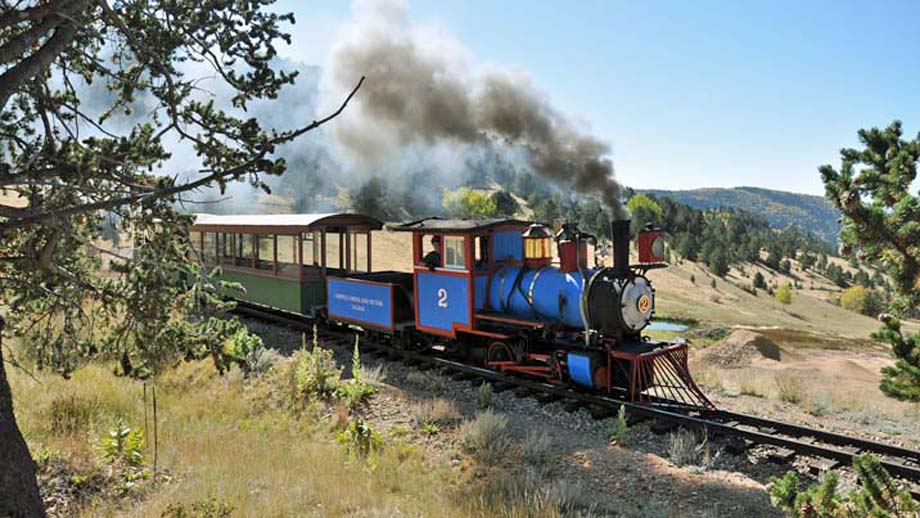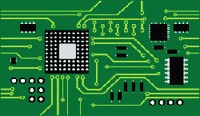

Previous to the present Cripple Creek & Victor Narrow Gauge Railroad several companies built into the area attracted by the 1890 Colorado gold rush. The first being the Florence & Cripple Creek Railroad (F&CC) which arrived at Cripple Creek in 1894. This 3 foot narrow gauge, known as "The Gold Belt Line", twisted, turned, tunnelled, and climbed nearly 5,000 feet from Florence through Phantom Canyon to Victor, the first main destination in the gold field.
Next site along the way were the mines located around Elkton of which the Elkton Consolidated Gold Mine was but one example.
The F&CC route then continued towards Anaconda where the wreck of their first passenger train occurred on 1 Jul 1894 during the return trip.
Finally the tracks reached their depot in Cripple Creek.
The Florence & Cripple Creek transported gold ore from the gold fields south to Florence for processing at works such as the American Reduction Company or interchanged it there with the Denver & Rio Grande Railroad.
With the area's gold acting as a magnet other railroads became interested so the F&CC was soon followed by several railways offering competition.
The standard gauge Colorado Midland Railroad connecting Colorado Springs to Leadville, another mining region, passed through the town of Divide on its east-west route.
From a junction at Divide the Midland Terminal Railway, originally constructed as 3 foot gauge but rebuilt to standard gauge by 1894, ran south to reach Cripple Creek and Victor.

The Midland Terminal Railway depot at Cripple Creek, built in 1895, still stands there today but it is now the Cripple Creek District Museum. Our tiny, comparatively new, CC&VNG railroad passes right by the museum on its way south to end-of-track.
And, on one last note about the district's history, there were electric street cars running between Cripple Creek and Victor on a daily basis, 24-hours-a-day. There were two lines named the High Line and the Low Line. The High Line connected downtown Cripple Creek via Midway (elevation 10,487 feet) to downtown Victor. The Low Line joined the same two cities via Elkton and Anaconda with a trolly car every thirty minutes. The fare was five cents.

After purchasing a ticket in the depot, which also contains a gift shop, the train is boarded. Open air coaches are pulled by the small steam locomotives. One version has a roof with open sides while the other is completely open. A wooden bench runs down the center of each so that riders face outwards when sitting. Although not the most comfortable the trip is short and there was plenty of room to stand and move about safely with lots of hand holds. Train speed is slow along a very well maintained track with fresh creosoted ties in evidence. A small operation using substantially heavy rail with a surprisingly well maintained right-of-way.
Immediately after leaving the Cripple Creek depot the train passes over a spring switch at a wye enroute southbound. On a high embankment the train next reaches Irene Street, really just a short dirt road, passing over it on a bridge that was obviously once a steel turntable. From this point there is a expansive view of the entire historic town of Cripple Creek to the northwest.Farther along the tracks run deep into the bush with glimpses of a broad valley falling away below. The route lies at about 10,000 feet elevation. There are several rock cuttings as the track cuts through ridge lines along its route.
Upon reaching the end-of-track the train stops momentarily while the engineer explains the workings of the huge open pit Victor gold mine visible way up on a hill to the south. Large dump trucks dump ore over a slope in a process called "heap leaching" where some nasty chemical separates the gold from the ore. Below the train Highway 67 winds around a valley which trails off into distant hills of Aspen and pine trees. The huge mine is one ugly beast on top of this gorgeous view down the valley.
The train then backs up to the wye a few hundred feet behind. Another spring switch lead the train into the tail-end of a wye, which is interesting, because this end lies on an embankment of tailings from an abandoned mine. Two ties stuck into the track in a "V" pattern act as an emergency bumping post. Not particularly reassuring as you look over the edge to the drop below.
The engineer, however, had a deft hand on the brake this time so we were spared any danger. He opens the throttle, tosses a couple of scoops of coal into the firebox and the train departs the wye through two more spring switches heading back to Cripple Creek.
Locomotive numbers 1 and 2, both built in Germany, were most likely originally constructed as tank engines. They have been modified with the addition of tenders, cabs, headlights, and cow catchers (pilots) to make them appear more American.
3 Sep 1897 - Railroad Squabble
1 Jan 1898 - Coup D'etat by F&CC Railroad
16 Apr 1899 - Rail Road Time Tables
25 Aug 1899 - Victor Swept by Flames
12 Sep 1899 - A Solid Train of Ore
18 Feb 1900 - Railroad Locals
28 Aug 1903 - Stike is Now Off at Portland Mine
10 Jun 1904 - Deadly Dynamite Explosion and Riots in...
8 Jul 1904 - Deadly Wreck
12 Nov 1904 - Anaconda Swept by Terrific Fire
11 Dec 1914 - Find High Grade Ore
11 Dec 1948 - Nazi Extortion
8 Jan 2006 - The $305 Million Pile
11 Jul 2013 - Expansion at Cripple Creek & Victor...
Cripple Creek & Victor Narrow Gauge Railroad
Florence & Cripple Creek Boxcar Decals
World's Greatest Gold Camp: Cripple Creek
El Paso Reduction Mill at Florence 1898
Cripple Creek & Victor Gold Mining Company (Link fails 26 Jul 2024)
YouTube video of a trip on the line





